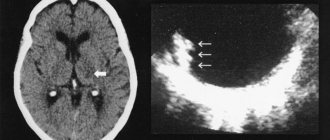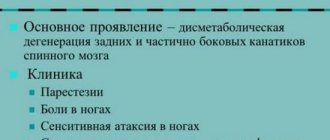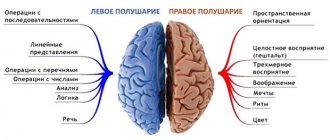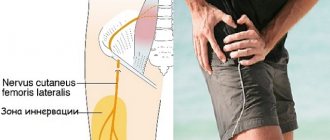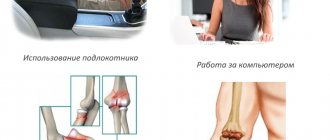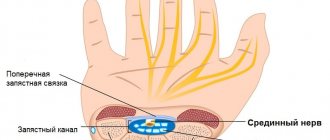Symptoms of Morton's neuroma
The following symptoms are observed with Morton's neuroma:
- The pain usually occurs after spending a certain amount of time on your feet. This time (before the appearance of numbness and pain) will decrease with the progression of the disease. In the case of Morton's neuroma, pain at night is rare.
- Electric shocks to the 3rd and 4th toes are possible.
- A burning, tingling sensation in the forefoot.
- Sensation of a foreign object in the shoe.
- In severe, advanced cases, pain can occur when you simply walk or even at rest.
- There are no visible external changes, since it is not actually a tumor, but a bundle of inflamed nerve fibers in the sheath.
- Symptoms usually do not come on suddenly, but take some time.
Action
By using only topical topical agents, it will not be possible to cure foot neuroma, but they help:
- significantly reduce pain;
- reduce swelling;
- minimize the manifestations of inflammatory processes;
- increase mobility of the affected area.
Due to local action, the drugs do not affect the gastrointestinal tract and liver, while demonstrating high efficiency. It is necessary to use any means only after prior agreement with your doctor.
Diagnosis of Morton's neuroma
The diagnosis of Morton's neuroma is usually made based on patient complaints and examination.
The examination consists of provoking symptoms of Morton's neuroma. That is, the doctor tries to compress the nerve between the metatarsal bones by squeezing the foot with a hand. If the nerve is thickened and inflamed, then within 30-60 seconds the patient begins to experience numbness and a burning sensation in the 3rd interdigital space. This way the diagnosis is confirmed.
X-rays or MRI are performed to exclude other pathologies (consequences of trauma, osteoblastoclastoma and other tumors and soft tissue diseases).
Homemade ointments
Homemade ointments, like other folk remedies for treating Morton's neuroma, help alleviate the course and minimize the symptoms of the disease.
The most effective include:
- Ointment based on animal fat (pork, badger, goose).
To prepare it, you need to take 100 grams of fat, add one spoon of table salt and mix thoroughly. Apply the resulting mixture daily to the inflamed area, gently rubbing. You can leave the product on overnight, applying a bandage and putting a warm sock on top.
- Ointment with bay leaves and pine needles.
You need to chop the bay leaf to make two tablespoons, and pine needles to make one tablespoon. Mix. You need to add fifty grams of butter to the resulting mixture and mix again. The prepared ointment is applied to the affected area daily.
Shoe selection
To choose the most comfortable shoes that will not aggravate the course of the neuroma, do the following. Get a pair with removable insoles, remove the insoles, and stand on them. If your feet are wider than the insoles, this pair is narrow for you. The shoes will put pressure on your foot, causing pain. And if you plan to additionally use orthopedic insoles, then you will need even wider shoes.
Special orthopedic shoes (sandals, shoes, boots) are rarely used in the conservative treatment of Morton's neuroma. Only after surgery to remove a neuroma, the doctor recommends wearing post-operative shoes with rigid soles or with forefoot unloading for several weeks after surgery.
Prevention methods
To identify the disease, the following diagnostic procedures are used:
- Inspection. The main sign of a neuroma is a positive reaction when the foot is compressed in the anterior plane. When performing such an action, acute pain occurs, radiating to the fingers, which are under the control of the affected nerve.
- X-ray examination of the foot. Most patients who consult a doctor with complaints of pain in the toes are found to have longitudinal-transverse flatfoot. However, the neuroma itself cannot be detected using an image. Computed tomography is not informative in this regard either.
- Magnetic resonance imaging. The procedure produces three-dimensional images in which the neuroma is identified as a limited area of increased signal. Visualization of the affected nerve is often difficult, which is why the results of the procedure are false negative.
- Ultrasonography. The most informative technique that allows you to accurately determine the location of the affected nerve. The procedure helps to identify post-traumatic changes, neoplasms, and degenerative-destructive changes in the joints.
Unlike benign neuromas, Morton's neuralgia is not a tumor, and its treatment is quite successful.
There are 2 main treatment methods:
- conservative therapy;
- surgery.
Conservative treatment includes non-surgical methods of therapy: the use of special orthopedic insoles, physiotherapeutic agents, and possibly treatment with folk remedies.
Metatarsalgia requires long-term conservative therapy, following certain rules:
- purchasing and constantly wearing comfortable shoes: without pronounced heels and narrow toes;
- use of orthopedic insoles;
- use of special toe separators to prevent toe deformation;
- reducing the constant load on the legs;
- use exclusively orthopedic shoes;
- regular foot massage courses;
- the use of drug treatment only after confirmation of the ineffectiveness of all the recommendations listed above.
Application of insoles
The doctor begins treatment for neuroma by introducing the patient into new, comfortable shoes that do not put uncomfortable pressure on the foot. The use of orthopedic insoles, which are made directly for the patient’s foot, is mandatory. Their action is aimed at restoring the transverse arch of the foot, as a result of which the compression of the nerve is reduced.
If orthopedic insoles do not help, begin using physiotherapeutic agents to treat neuroma of the foot. An orthopedic doctor gives a referral to a physiotherapist who performs shock wave and magnetic therapy, and uses the electrophoresis method on the foot. Sometimes up to 10 sessions of acupuncture are indicated.
If such treatment does not bring the desired effect, the traumatologist performs a blockade with hormonal drugs - corticosteroids.
For permanent relief of pain, NSAIDs are prescribed: Nimesulide, Diclofenac, etc.
It is carried out only under the supervision of a doctor, with his permission.
- Make compresses with fresh wormwood at night for a month, first grinding the herb to a paste.
- Salted lard is used to soften the compacted fibrous sheath of the nerve and relieve pain. The lard is melted; Having received 100 g, add 1 tbsp. a spoonful of table salt. Make compresses from the resulting mixture for ½ day. Repeat daily until pain relieves.
- Use vinegar baths by diluting 0.5 apple cider vinegar in 5 liters of hot water. Soak your feet in the solution for half an hour.
Any side effects that occur require discontinuation of treatment and consultation with your doctor.
There are four main types of foot surgery for Morton's neuroma:
- excision of formation;
- removal of the entire pathological area;
- expansion of the space around the nerve;
- intentional bone fracture.
Removal of Morton's neuroma is performed under local anesthesia in a small operating room, without prior preparation of the patient. The surgeon dissects the intermetatarsal transverse ligament, followed by excision of the neuroma, sometimes with the affected area of the nerve. After which he sutures the wound, followed by removal of the sutures after 14 days.
Surgical treatment in the form of removal of the entire inflamed area of the foot is performed as a last resort. A complication of the operation is finger anesthesia - loss of sensitivity.
The release (relaxation) of the ligament is carried out by cutting it, thereby expanding the space around the nerve.
Very rarely, an intentional bone fracture is used, which is performed under x-ray guidance and allows to reduce or remove the compressive effect on the nerve, displacing the bone.
These surgical interventions do not require special preparation of the patient and have virtually no contraindications. However, the recovery period after any of these manipulations is quite long.
Causes
The following factors can provoke the occurrence of Morton's neuroma:
- Wearing uncomfortable shoes.
- Frequently wearing high heels.
- Excess body weight.
- Incorrectly developed posture.
- An infectious process that occurs over a long period of time.
- Prolonged and regular standing.
- Excessive stress on the legs.
- Flat feet.
- Inflammatory diseases in the foot area.
- Joint pathologies.
- Tumors compressing the nerve in the foot area.
- Suffering injuries in which nerve endings were damaged.
- Other diseases that can affect the nerve of the sole.
The disease can affect anyone, regardless of age and gender.
Signs of the disease and their diagnosis
Like other diseases, foot neuroma is best treated if symptoms are identified and diagnosed early. A feeling of numbness, burning and aching pain in the toes are the first signs of inflammation of plantar neuritis (one of the names of the disease).
At the initial stage, after a light massage and relieving compresses or baths, the symptoms disappear over time, and under the influence of already known causes they reappear, more aggravated and painful, regardless of the quality and comfort of the shoes.
The first examination and identification of the damaged area is carried out using palpation. At the same time, the doctor conducts a survey of the patient, clarifying the causes and time of onset of painful sensations. For an accurate diagnosis, excluding fracture or arthritis, which has similar symptoms, in-depth studies using X-rays, magnetic resonance imaging and ultrasound are used.
Gait study
A new method for identifying the disease is a computer study of gait, which, under the influence of pain, acquires characteristic changes.
Conservative treatment of neuroma
Treatment for this fibrous thickening is to relieve pressure on the pinched nerve and eliminate possible inflammation.
In addition to injections into the foot of non-steroidal anti-inflammatory drugs, which have a strong negative effect on the mucous membranes and blood vessels, the patient is recommended to wear shoes of a strictly specific style:
- ban on narrow toes;
- A low heel and a “worn out” last are required.
Sometimes the development of the disease can be stopped through the use of orthopedic insoles. Postponing the treatment of this disease “for later” leads to aggravation of the situation. Pain begins to appear when wearing any, even the most “gentle” shoes.
The duration of the course of therapy is several months. If the result is negative (and this happens quite often), the attending physician may prescribe physical procedures - magnetic therapy or electrophoresis.
If in this case the result is negative, surgical intervention is recommended. The operation is performed under local anesthesia.
What does surgery on a neuroma give?
Simultaneously with the removal of Morton's neuroma, the surgeon may perform the following manipulations on the foot:
- elimination of a certain section of nerve fiber;
- releasing space around the nerve to reduce pressure on it;
- dissection of the intermetatarsal ligament;
- osteotomy (artificial fracture) of the fourth metatarsal bone.
In order not to bring the matter to the point of surgery and not to subject your limb to such a test, you need to find an effective method of physical treatment that would solve the problem.
Morton's disease etiology
The mechanism of development of Morton's syndrome (metatarsalgia) includes:
- repeated mechanical action of the intermetatarsal ligaments on the plexus of the internal and external nerves of the foot;
- damage to bone and soft tissues, leading to compression of the nerve roots in the little finger area;
- reactive degeneration of nerve tissues, accompanied by the formation of areas of increased growth;
- hypertrophy of connective tissue fibers surrounding nerve endings;
- the formation of inflammatory infiltrates, as a result of which nerve fibers become fused with the surrounding soft tissues and nearby bone;
- inflammation of the nerve roots of the foot, leading to pain.


